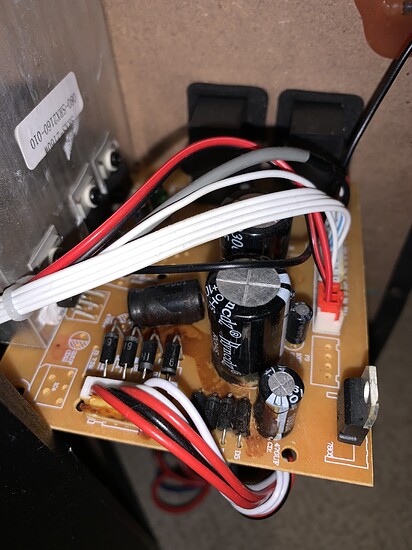Can you tell me if it can be repaired and if so, what parts do I need? And for the context, my subwoofer started making a loud noise when is on. I opened it to look at the amplifier and noticed that there was a melted brown substance that I removed, you can still see the traces where it was. And now I see that some parts at the base are melted!? What can I do?
how did it die?.. you accidently killed it poking at it? or it just went pop?.
if you killed it accidentally then yeah you could just replace like for like for damaged parts.
same resistance resistors, same volt and farad caps. and so on. remember to test with a meter.
both to find damaged components and after your done replacing them.
if it just went pop, then the best option would be to replace the whole pcb.
tbh probably the best option all round…
coz it will just be a case of plugging wires and no soldering and chances of you getting polarity wrong…
so… yeah maybe look up the amp pcb model and see if you can get a replacement.
or even something a little better and swap it out.
the melted brown substance around the base of the caps, looks like leaked electrolyte.
while the yellow brown stuff on the power connector looks like flux residue.
This is probably just glue, they usually glob it on to stop vibration. As it ages it can get darker and look burnt. It’s possible that the glue has also become conductive with age, this was common with older stuff before they knew the glue was no good.
It’s not really obvious what’s gone bad but if you know what you’re doing with a multimeter you might be able to track down a dead part and replace it. But it may just not be worth trying to fix.
Amazon and ebay have low cost plate amps that can be retro-fitted into those things usually.
the small 470UF capacitor looks scorched by that brown mark, and is that a leaky trail out of it?
if thats the case, capacitors are easy to replace: desolder the old one and add one of matching capacity.
edit: oh, its mentioned to be glue. nvm
Replace the cap laying on its side and the diodes near the scorched cap.
See that’s the thing, while one could replace individual components, when catastrophic electrical failure happens, it cant be just caps that are affected. Down the circuit there must be other electrical failures that happen when the first capacitor pops/melts/leak and that feels like you should know what else could fail, not just what is visibly faulty. Identifying those parts seem like you need formal electronics training.
Silicon diodes have a .06 to .07 voltage drop.
Most likely those may be 1n4001 diodes.
If they have a large voltage drop they are open.
If no voltage drop at all they are shorted.
Either way they would be bad.
They are easy to replace as long as the cathode orientation is correct.
Germanium diodes have a .03 to .05 voltage drop.
They are generally used for signal detection in rf circuits.
However many circuit designs use a schottkey diode for signal detection as they tend to be a bit more robust.
It helps to look at a circuitboard like blocks of components so its easier to repair.
And circuit tracers are valuable assets for quick identification.

